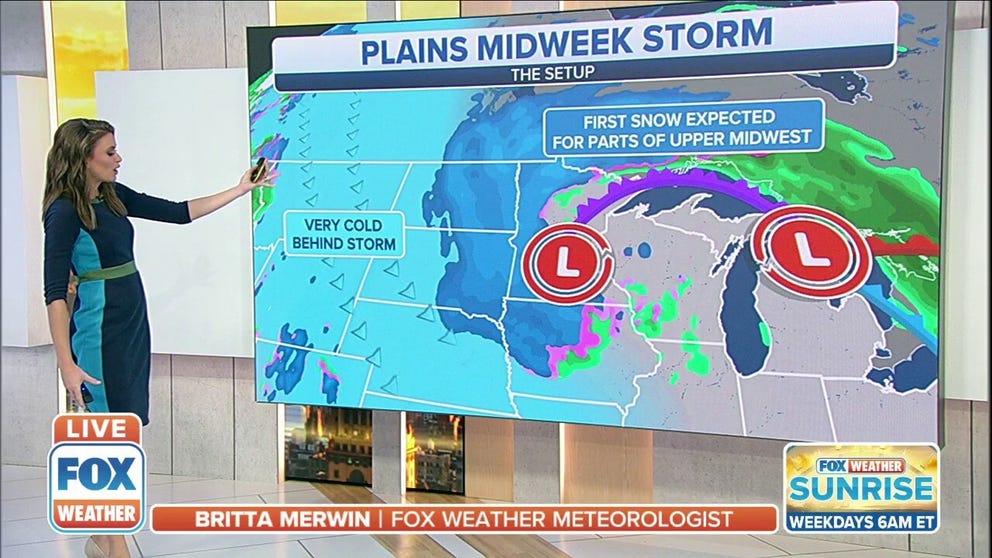Coast-to-coast storm to bring snow, severe storms and strong winds to Plains, Midwest ahead of Veterans Day
The storm will arrive in the Plains on Wednesday and reach the East Coast by Friday
Plains, Midwest gearing up for severe storms and snow
Coast-to-coast storm to bring snow, severe storms and strong winds to Plains, Midwest ahead of Veterans Day.
A powerful storm system sweeping across the United States ahead of Veterans Day will bring snow, rain, severe thunderstorms and strong winds to the Plains and Midwest starting Wednesday before spreading into the eastern states late this week.
This storm first crashed ashore along the West Coast Monday night. Rain, mountain snow and gusty winds will continue across the West on Tuesday before shifting toward the central and northern Rockies Tuesday night.
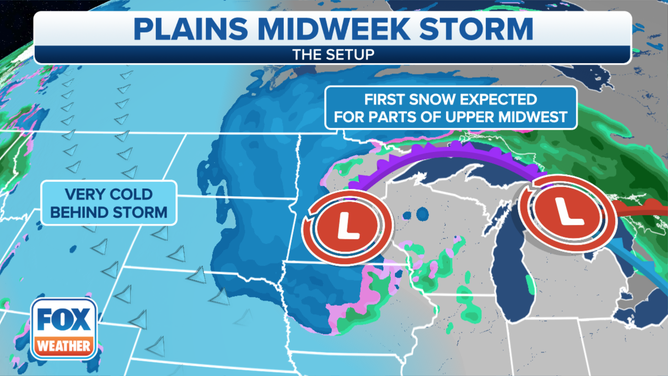
A powerful storm will emerge over the Plains and Midwest ahead of Veterans Day.
(FOX Weather)
By Wednesday, the powerful storm will emerge over the Plains, setting the stage for an active day of weather across the central U.S., with parts of the Midwest and South then getting involved Wednesday night into Veterans Day and the East Coast by Friday.
Much colder air will follow in the wake of the storm across the central and eastern U.S. after an unseasonably warm start to the week.
WARMER-THAN-AVERAGE WEEK AHEAD FOR MANY BEFORE COLDER AIR RETURNS
Snow and rain impacts
While many areas will see a soaking rain with this system, parts of the Northern Plains and upper Midwest could see their first significant snowfall of the season Wednesday into Friday.
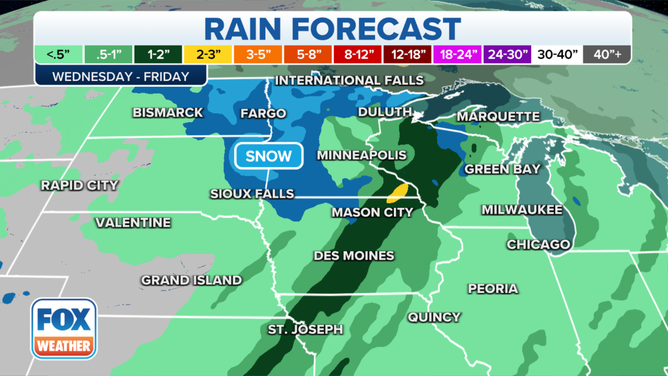
Rainfall forecast Wednesday through Friday. Since this extends a few days into the future, the forecast could change with future updates.
(FOX Weather)
Precipitation will likely begin as rain, but colder air will quickly rush in and change the rain over to snow starting in northeastern North Dakota Wednesday morning, then in northwestern Minnesota Wednesday afternoon.
Wednesday night, rain will turn to snow across the rest of northern Minnesota as snow tapers off in North Dakota.
On Veterans Day, snow will continue in northern Minnesota, and rain will change to snow in north-central Wisconsin and the western Upper Peninsula of Michigan. A second batch of snow will also develop back to the west over parts of the Dakotas as much colder temperatures build in on the backside of this storm.
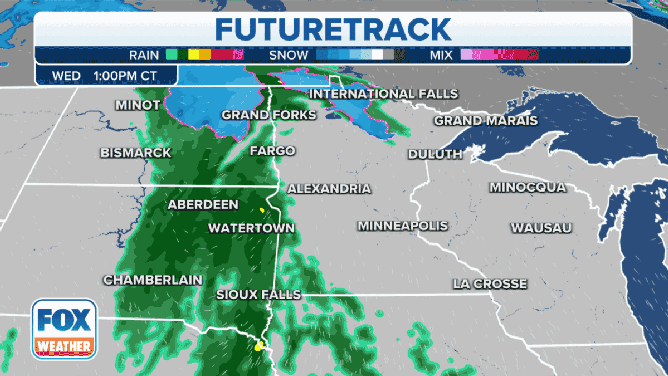
(FOX Weather)
Thursday night into Friday, snow will continue across the central and eastern Dakotas and spread into western and northern Minnesota and far northern Iowa. A rain-and-snow mix is possible over parts of Wisconsin, northern Illinois and the western Upper Peninsula of Michigan.
The precipitation should come to an end in most of these areas Friday night or early Saturday, though lake-effect snow is expected to develop downwind of the Great Lakes into the weekend.
The heaviest snow is projected to fall from eastern portions of the Dakotas into northern and western Minnesota, with lighter accumulations expected elsewhere. However, it is too soon to predict exact snowfall totals, so check back with FOX Weather for updates.
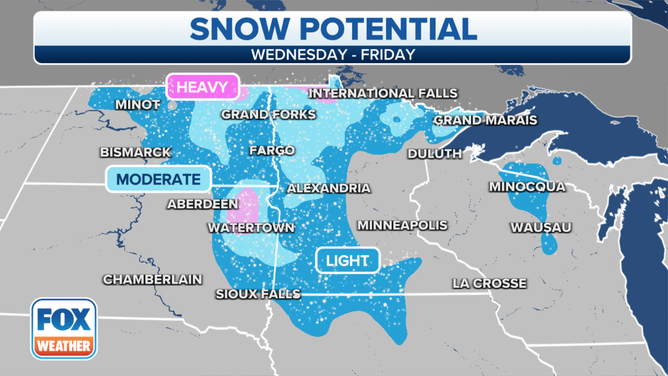
Potential snowfall Wednesday through Friday. Since this extends a few days into the future, the forecast could change with future updates.
(FOX Weather)
This system will also spread rain across the South and the Mississippi, Ohio and Tennessee valleys Thursday into Thursday night.
On Friday, rain will move through the eastern states from New England to the Carolinas before the storm pushes off the East Coast Friday night.
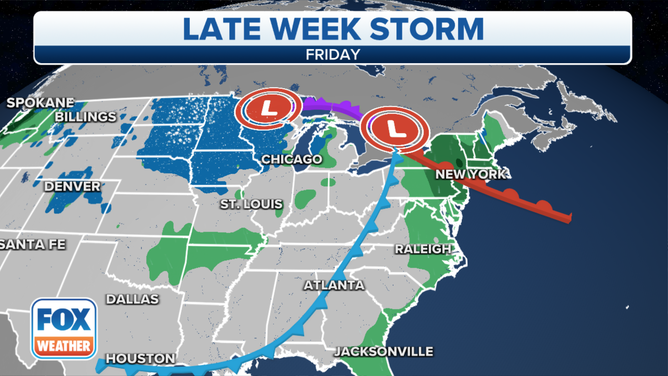
Friday's rain/snow outlook. Since this is a few days into the future, the forecast could change with future updates.
(FOX Weather)
Wind impacts
Gusty winds will accompany the snow and rain in the Plains and Midwest starting on Veterans Day.
The highest winds on Veterans Day will target areas from the Dakotas to the western Great Lakes, where widespread wind gusts of 20 to 40 mph are likely. Gusts up to 50 mph are possible over the western Dakotas.
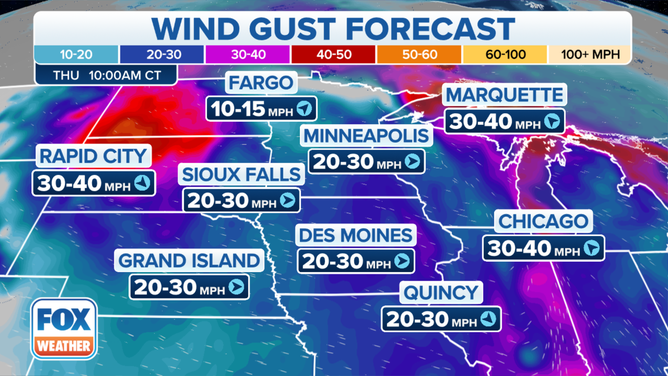
Wind gust forecast on Thursday, Nov. 11, 2021.
(FOX Weather)
On Friday, winds are forecast to be even stronger, especially from the eastern Dakotas southeastward to Iowa, Missouri and western Illinois. Winds could gust to 50 mph in these areas, with isolated spots gusting to 60-plus mph.
In places where snow is falling, these high winds will lead to blowing and drifting snow, meaning visibility could be reduced to near zero at times. This is especially hazardous for motorists, so you're advised to use extreme caution if you must travel on Veterans Day or Friday.
WHAT YOU SHOULD KNOW ABOUT BLOWING, DRIFTING SNOW
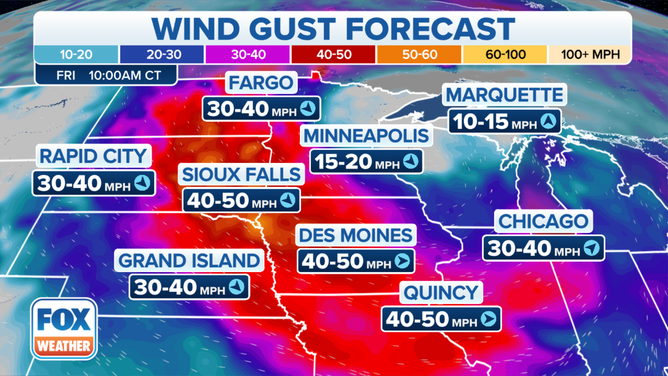
Wind gust forecast on Friday, Nov. 12, 2021.
(FOX Weather)
Severe thunderstorm impacts
The southern end of this storm's cold front will sweep across the Southern Plains on Wednesday.
As a result, a few severe thunderstorms are predicted to develop over parts of Oklahoma, North Texas and south-central Kansas Wednesday afternoon and evening.
Large hail, damaging winds and an isolated brief tornado are all potential threats with the severe storms.

Severe storm threat on Wednesday, Nov. 10, 2021.
(FOX Weather)
On Thursday, isolated thunderstorms are possible across much of the South. However, the risk for severe storms is very low because widespread rain will prevent the atmosphere from becoming unstable.
